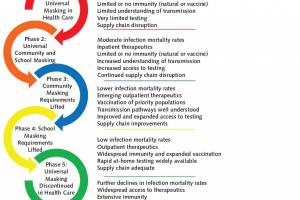SARS-CoV-2
Severe Acute Respiratory Syndrome Coronavirus-2 (SARS-CoV-2)
The Severe Acute Respiratory Syndrome Coronavirus-2 (SARS-CoV-2) was identified in China in 2019 and confirmed by the World Health Organization (WHO). As the name indicates, this coronavirus is related to the SARS beta coronavirus (SARS-1) that caused fatal outbreaks in 2002-2003. However, it is not the same virus, says the U.S. Centers for Disease Control and Prevention (CDC). By the third quarter of 2022, the CDC reported that an estimated 96.4% of blood donors had SARS-CoV-2 antibodies from previous infection or vaccination, including 22.6% from infection alone and 26.1% from vaccination alone; 47.7% had hybrid immunity.
The U.S. government's Project NextGen, Defeating SARS-CoV-2 and Preparing for the Next Pandemic, expects SARS0CoV-2 to continue to evolve in 2023. In molecular epidemiology, a study published on May 4, 2021, found the progenitor genome (proCoV2) is the mother of SARS-CoV-2 coronaviruses. These researchers estimate that the SARS-CoV-2 progenitor was in circulation several weeks before the first genome sequenced in China, known as Wuhan-1, stated Sayaka Miura, a study's senior author. In addition, a report issued by Sen. Marco Rubio and staff in 2023 indicated vaccine research was active by November 2019.
SARS-CoV-2 Variants of Concern
The coronavirus that causes COVID-19 is mutating, which is expected as viruses mutate as they spread, stated the U.S. CDC. The original SARS-CoV-2 strain, detected in Wuhan, China, in December 2019, is the L virus strain. This human coronavirus (hCOV) has since mutated. A study published in April 2023 evaluates uncertainties and outlines scenarios for the possible evolutionary trajectories of SARS-CoV-2.
The WHO, in collaboration with partners, expert networks, national authorities, institutions, and researchers, has been monitoring and assessing the evolution of SARS-CoV-2 since January 2020. As a result, the WHO updated its tracking system and working definitions for variants of SARS-CoV-2 in March 2023 to better correspond to the current global variant landscape, to independently evaluate Omicron sublineages in circulation, and to classify new variants more clearly when required. For the updated definitions, please visit the WHO variant tracking website.
The CDC posts SARS-CoV-2 Variant Classifications and Definitions at this link.
SARS-CoV-2 Coronavirus FAQs
NOTE: This page's content is sourced from the CDC, WHO, clinicaltrials.gov, and the Precision Vax network of websites. Healthcare providers fact-checked this information.





